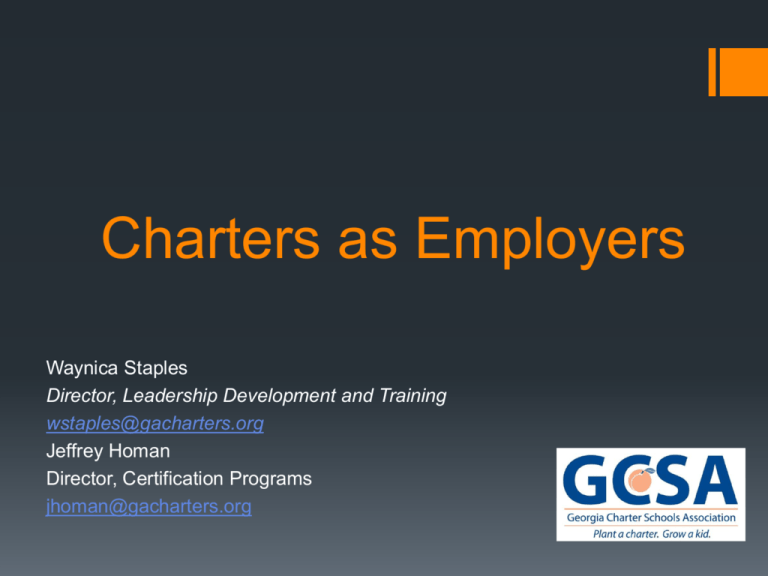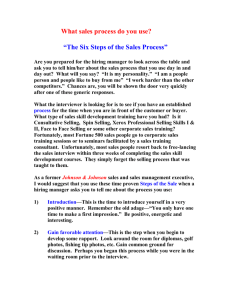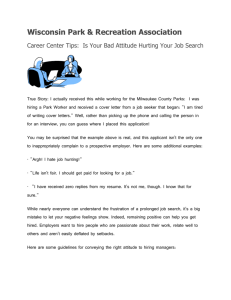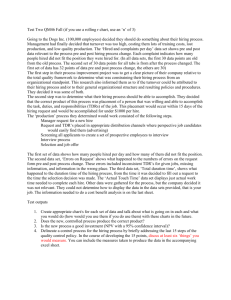Hiring, Supporting, Monitoring, Evaluating, and Retaining Highly
advertisement

Charters as Employers Waynica Staples Director, Leadership Development and Training wstaples@gacharters.org Jeffrey Homan Director, Certification Programs jhoman@gacharters.org How Much Does Good Hiring Impact Student Achievement? #1 factor influencing student achievement is the quality of the teacher. (Marzano, 2005) Research says…. #2 factor influencing student achievement is the quality of the leader. (Hallinger and Heck, 1996) Principal’s role in selecting the right people includes both instructional and non-instructional staff. (Portin and colleagues, 2003) Some General Statistics Research (National Center on School Choice, 2010) says… Charter school teachers have significantly higher turn over rates 130% greater for leaving the profession 76% greater for moving schools Start up charters have higher turn over than conversions 2x higher EMO vs. non-EMO no significant difference New schools versus schools 3+ years no significant difference Some General Statistics Teacher characteristics play the largest role in turnover rates in charters. More often than not, charter teachers are: Younger Less experienced Part-timers (2x likelier to leave) Uncertified (200% greater likelihood of leaving) Strong academic backgrounds more likely to leave the profession…presumably skill set is transferrable to other professions New teachers the most likely to leave…and most likely to be replaced with other new teachers…cycle continues. Some General Statistics Dissatisfaction with working conditions also play an important role (“teachers voting with their feet.”) Dissatisfied with school (teachers will be as dissatisfied with charters) Dissatisfaction with work conditions Lack of administrative support Involuntary attrition is higher in charters Charters have greater flexibility with personnel policies Underperforming staff or staff not meeting ESEA requirements Why Does It Matter? Attrition impacts many things in your school…. Staff morale Trust Instructional cohesion Sustaining student enrollment Sustaining financial operations Program implementation The Leader’s Role Effectively…. Hire (board must ratify all hiring decisions) Support Monitor Evaluate Create positive working conditions/culture Success in these will lead to higher staff satisfaction, retention and student achievement. Hiring Quality Teachers and Staff Agree or disagree? Why? People are your most important asset. Selecting Quality Teachers and Non-instructional Employees Is this any closer to truth? The RIGHT people are your most important asset. Considerations in Hiring… Pre-work Expected outcomes for the position Job description and additional duties Requisite education, training, and experience Highly Qualified? (must be HQ) Certification? (new PSC requirements) Dispositional / “Fit” Age/grade Demographics Team and school culture/disposition Compensation Considerations in Hiring… Interview and Selection Credentials (Minimal training, education, experience) Recommendations Who’s important? Who does a candidate NOT want you to talk to? Red flags? Screening Takes place after credential screening 15-30 min. General questions on qualities of effective teachers Determines if interview should be invited to building level interview. Considerations in Hiring… Interview and Selection Building Level Interviews – consider having a consistent panel 45 min. – 1 hour (teams) Asks in-depth, probing questions geared at determining qualitative value of judgment, level of competency, and application of skills (see CLASS Keys) Questions are targeted….You’re looking for specific types of responses that match the expectations for the position or the type of candidate How…Why… Describe a time… Give an example… Evaluates 3 critical areas: 1. Training and experience 2. Skills and competencies 3. Disposition After the Interview Keep all applicant information such as resumes, interview notes, assessments, etc. Be able to answer: “Why did you hire this person?” “Why didn’t you hire this person?” Follow-up with candidates Illegal Interview Questions Employers should not ask about any of the following unless it specifically relates to the job requirements, because to not hire a candidate because of any one of them is discriminatory: Race Color Sex Religion National origin Birthplace Age Disability Marital/family status Common Mistakes Principals Make Untrained interviewers (illegal or unskilled questioning) Interviewer prejudices left unchecked Over-reliance on interviews (credentials, recommendations under emphasized or unchecked) Improper hiring criteria Failure to adequately assess qualitative attributes (skill, impact) Common Employer Mistakes Insufficiently vetting candidates Use local connections Lack of focus on differences between traditional and charter schools as workplaces Lack of understanding of budgeting, compensation models Not considering hiring when planning school schedule When will teachers be available? Insufficient focus on mission and vision, school culture Not creating a palpably supportive opportunity culture No plan for dealing with terminations, non-renewals, suspensions, PSC ethics violations…… The Importance of Induction and Support of New Teachers… New to the Profession New to the Charter School • 1/3 of new teachers leave the profession during their 1st 3 years of teaching • Almost ½ leave within 5 years • Specialized fields like SPED have even higher rates of attrition • In charters…. • 130% great chance of leaving the profession • 76% greater for moving schools What is Induction and Why Is It Needed? An active, 2-3 year systematic training and supporting process focused on 4 key objectives: 1 2 3 4 • Ease transition into teaching and/or into the charter school environment • Improve effectiveness (i.e., teaching effectiveness, classroom management, and instructional delivery) to align with charter philosophy and mission • Promote the school’s culture • Increase staff retention rates Mentoring/Supporting Novice Teachers Process – 1-3 years Requires sustained support and guidance from veteran teachers or principal Focus on: Instructional planning and delivery Classroom management Administrative efficiency and effective processes Learning the ropes Risk free – opportunity to share failures, question, and to vent frustration…in return for suggestions and resources, answers, a listening ear, another perspective Considerations: “Match” of skills and dispositions Time commitment Expectations and accountability to fidelity of the program Phases of First Year Teaching ANTICIPATION ANTICIPATION REFLECTION SURVIVAL REJUVENATION DISILLUSIONMENT AUG SEPT OCT NOV DEC JAN FEB MAR APR MAY JUN JUL Source: Lipton & Wellman (2003) Mentoring Teachers New to the Charter School Process – at least 1 year Requires sustained support and guidance from teachers who have been at the school and share the vision and philosophy Focus on: Understanding the school’s culture Implementing the school’s instructional philosophy and practices into the classroom Learning the ropes Risk free – opportunity to share concerns, question, and to vent frustration…in return for suggestions and resources, answers, a listening ear, another perspective Considerations: “Match” of skills and dispositions Time commitment Expectations and accountability to fidelity of the program Effective Leaders Create the Environment Leaders must explicitly show their values to influence the values of the organization: Expect professional development of everyone in the building (including themselves) Make time in schedules, agendas, school calendars Share (frequently) latest theories, trends, research, strategies, reports, articles, etc. Engage themselves in professional development (that means sometimes leaving the building!) Recognize completion and achievement of individuals, groups, and the school in professional development Provide essential resources to support growth of staff Support peer collaboration, observation, discussion Encourage reflection Support opportunities to share best practices among the experts in your building Organize study groups, have shared readings, discussion Find the funds to support training and procurement of key resources HR Policy Considerations… Employment Law and Labor Relations Wage and Hour-Fair Labor Standards Act Family and Medical Leave Act Equal Employment and Prohibition Against Discrimination Sexual Harassment Child Labor Drug Free Workplace Workers Compensation Privacy Wage Garnishment Jury Duty Military Leave Employee Handbooks Hiring Practices Employment Status Interviewing Offer Letters Documentation Orientation Termination and Exit Interviews Ethical Matters Risk Management Training, Motivation and Retention Staff Development Mentor Programs HR Policy Considerations… Employee Dress Code Policy Professional Organization and Labor Union Policy Possession of Weapons by Employees Policy Professional Duty Free Lunch Policy Professional Personnel Staff Meetings Policy Professional Personnel Additional Duties Policy Sick Leave Bank Policy Salary Deductions Policy Staff Development Policy Staff Complaints and Grievance Policy Personal Leave Policy Substitute Teachers Policy Mandatory Reporting of Child Abuse Policy Nepotism Policy Mandatory Reporting of Employee Crimes Policy Communicable Diseases Policy Employees Seeking or Holding Political Office Policy Fundraising and Solicitation Policy Gifts to Staff Policy Staff Conflicts of Interest Policy Criminal Background Check and Fingerprint Policy Professional Personnel Ethics Policy Employment Application “At will” Employment and Due Process How do you define “at will”? What about “due process”? Documentation What should you document? Just about everything! Common pitfalls: No documentation at all; sub-par documentation; After-the-fact documentation Good documentation creates and irrefutable record Good documentation puts all parties on notice Good documentation prevents the “he said – she said” Good documentation assists in completing performance evaluations, goal-setting, lay-off decisions, and termination decisions. Disciplinary Process (Adults) Consistent disciplinary processes encourage good behavior, discourage bad behavior, and improve employee performance. Disciplinary steps: 1. Verbal counseling or coaching 2. Formal written reprimand 3. Development of Professional Improvement Plan 4. Suspension (with or without pay) 5. Last chance agreements 6. Separation (voluntary or involuntary) Waynica Staples wstaples@gacharters.org 404-835-8914 Jeffrey Homan jhoman@gacharters.org 678-544-8152 Thank you!





